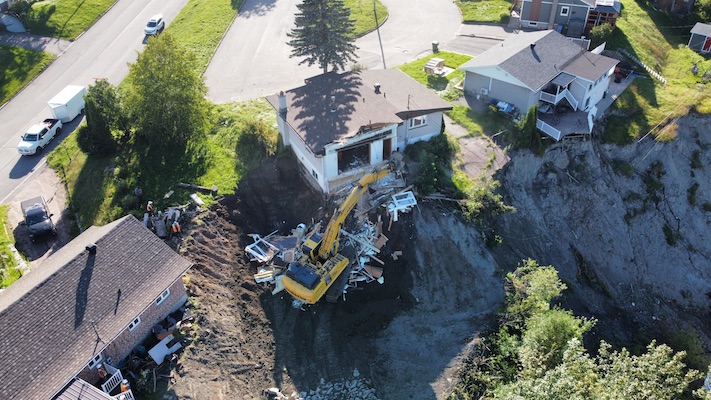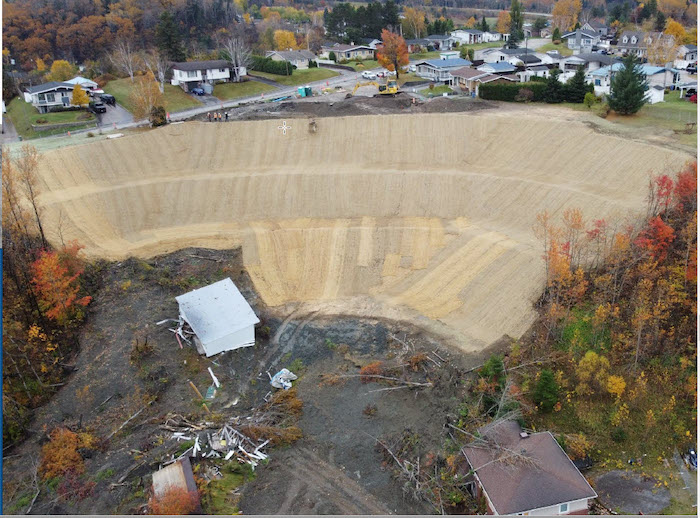
2023 #CCEAwards Showcase: La Baie Landslide and Embankment Restoration
November 7, 2023
By CCE
“The team used technical expertise and important human connections to control chaos. Their work directly saved lives.” – Jury
Category: Water Resources
Award of Excellence Winner: Englobe
During a regional state of emergency in 2022, the City of Saguenay, Que., sought to protect its residents from landslides. Englobe provided key geotechnical analyses and supervised emergency stabilization work, citizen evacuations, recovery of property, destruction of residences at risk and restoration of the damaged embankment.
A technical and human effort
In April 2022, as soon as the snow melted, several major landslides occurred in the greater Saguenay region. The City of Saguenay mandated Englobe to carry out an in-depth analysis of several embankments to detect further risks.
When the firm’s team detected major cracks in an embankment in La Baie, aggravated by intense rains comparable to those of the 1971 Saint-Jean-Vianney disaster, it immediately recommended a preventive evacuation of eight residences and 30 inhabitants. From there began an investigation campaign, led by Englobe, the city and the Quebec ministry of transportation’s geotechnics and geology department.
On June 13, 2022, a landslide occurred in La Baie and a regional state of emergency was declared, with the urgent evacuation of 21 additional residences. Englobe supervised the installation of concrete blocks to demarcate the sector at risk.
In less than 48 hours, the team orchestrated a constant watch of the damaged embankment with a drone, cameras and geotechnical experts. Along with piezocone drilling, this effort identified the presence of a highly sensitive layer of clay-like soil, capable of causing dangerous mudslides and additional landslides. The risk zone was enlarged.
Englobe next oversaw the emergency evacuation of 60 homes and 200 residents and continued to supervise emergency stabilization measures, including the installation of dikes and low walls and restoration and stabilization work on the damaged slope. This work was partly carried out with phytotechnology, which is based on biomimicry and integrates concepts of civil engineering, forestry and agronomy to improve the safety, durability and socioeconomic value of treated soils.
As the team conducted risk analyzes on 50 similar residential sites, its efforts helped comfort hundreds of worried citizens. The key was to remain agile and flexible to manage both the technical and human aspects of the project, from beginning to end.
Multidimensional challenges
Once the regional state of emergency was declared, the team had to temper social chaos and civic concern by very quickly marking out critical initiatives in a highly detailed project.
In close collaboration with—and support of—experts from the City of Saguenay, the Ministère de la Sécurité publique du Québec (MSP) and the Ministère du Transport du Québec (MTQ), Englobe immediately mobilized a multidisciplinary team at the provincial level and organized their work according to specific project stages, subject to established contractual standards.
When working with municipal and provincial stakeholders, given their varied procedural velocities, it was difficult to use different administrative apparatuses to obtain all of the project components on time. By creating a robust operational chain, Englobe enabled privileged and rapid access to the decision makers and resources necessary to carry out the project.

Homes in risk zones were evacuated and, in some cases, destroyed before further landslides could occur. Photo courtesy Englobe.
Aggravating weather conditions made the mandate more complex. The arrival of ground frost, a significant supply of snow and rapid melting created a ‘perfect storm’ for the occurrence of additional potential landslides on a regional scale. Subject to the same state of emergency, Englobe had to manage similar events simultaneously and with extreme efficiency across the vast territory of Saguenay, in a very short time.
Given the high profile of the event, the team also had to minimize informational leaks. They centralized and homogenized information in a weekly log summary, while ensuring the technical and administrative correctness of the interventions carried out by municipal officials within the crisis unit created for this purpose.
Saving lives
The first preventive evacuations carried out in April saved the lives of the residents of a house that was later destroyed in the June 13 landslide. And by significantly expanding the area at risk, Englobe’s team carried out the total emergency evacuation of 83 residences, potentially saving 230 residents.
The project stabilized the unpredictable clay-like soil that had been weakened by heavy seasonal rains, relieving it of considerable weight. Englobe’s supervision of work to strengthen the risk zone made it possible to secure municipal works, pharmacies, banks, supermarkets and a wastewater treatment plant, preserving local jobs, access to essential services and, above all, the normal daily life of the area’s residents.
Englobe intervened on more than 50 sensitive site that presented similar risks during the same period and managed locals’ concerns, the process of destruction and evacuation of residences at risk and mobilized the necessary human and material resources.
Restoring the ecosystem
Following the landslide’s damage to La Baie, a classic method of soil stabilization by rock was initially used. Given Englobe’s experience in phytotechnology, the team later improved upon this technique by integrating revegetation. This method not only improved and embellished the existing environment, but also was perfectly adapted to the particular, clay-heavy constitution of the soil.
In fact, the root network of the planted species not only restored and solidified the damaged slope, but also dried the soil more quickly following heavy rains, further reducing the risk of clay liquefaction that could cause dangerous mudslides. The durability of the damaged ground could be ensured while effectively preventing future similar incidents.
To restore the ecosystem to its original state while respecting it, it was essential to study it well. After this analysis, the team favoured the use of local native species, including white spruce, balsam fir, jack pine, ninebark and dogwood. Mixing civil engineering and agronomy, they restored the damaged environment and erased the vestiges of the disaster.
La Baie Landslide and Embankment Restoration, Saguenay, Que.
Award-winning firm (geotechnical analysis and prime supervisor): Englobe, Laval, Que. (Mike Cormier, P. Eng.; Noureddine Ghlamallah, P. Eng., Ph.D.; Stéphane Lavoie, P.Eng.; David Boily, P.Eng., M.Sc.; Nicolas Martel, P.Eng., M.Sc.; Émie Racine, CPI; Yannick Leblanc, Tech; Pierre Amyot, P.Eng.).
Owner: City of Saguenay.
Other key players: Municipalité de La Baie (contracting authority), MTQ (designer of measures and intervention plans), MSP (financial backer), Soleno (rainwater management system), IPEX (high-density polyethylene (HDPE) pipe manufacturer), Tuvico (concrete pipe manufacturer), Excavation J. Poulin (general contractor, heavy equipment).
